Selected Publications and Reports
The downloadable publications shown below are provided as examples of the range of projects that have previously been undertaken and to give an indication of the type and quality of outputs that can be expected. Many are the result of the necessary collaborative or team efforts that are required for large projects, but some reflect work completed while operating as an independent researcher and author.
Sea: images from the edge by Graham Saunders.
A self-published personal photographic celebration of some of the world's shores and shallow seas. All images were selected from my extensive library which extends back to the early 1980s.
The book can be browsed and purchased here.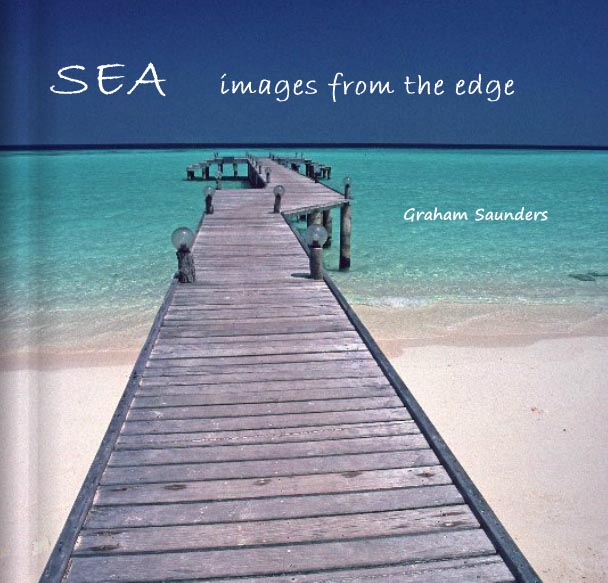
Moore, C. G., Harries, D. B., Tulbure, K. W., Cook, R. L., Saunders, G. R., Lyndon, A. R., Kamphausen, L., and James, B. (2020). The current status of serpulid reefs, horse mussel bedsand flame shell beds in Loch Creran SAC and MPA. Scottish Natural Heritage Research Report No. 1156.
The report can be obtained here.
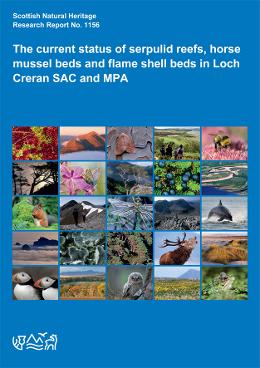
Aslan, H., Saunders, G., Kaboğlu, G., Yokeş, M. B, Okudan, E. S. and Gönülal, O. (2018). Preliminary Spatial Study of the Shallow Marine Communities of Gokceada Island Using Geolocational Habitat Mapping Techniques. Proceedings of the International Symposium on Fisheries and Aquatic Sciences 2018, Ankara, Turkey.
The paper is available to download here.
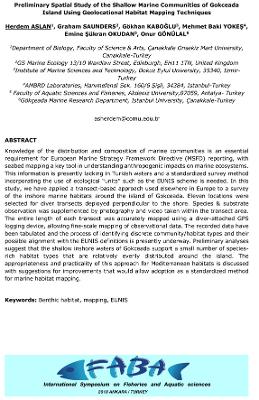
Moore, C. G., Harries, D. B., James, B., Cook, R.L., Saunders, G. R, Tulbure, K. W., Harbour, R. P. and Kamphausen, L. (2018). The distribution and condition of flame shell beds and other Priority Marine Features in Loch Carron Marine Protected Area and adjacent waters. Scottish Natural Heritage Research Report No. CR1038.
The report can be obtained here.
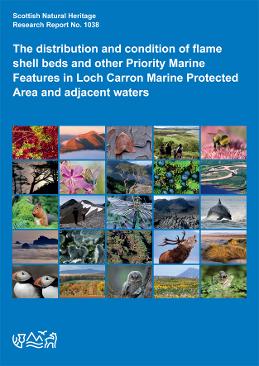
Gubbay, S., Sanders, N., Haynes, T., Janssen, , J. A. M., Rodwell, J.R., Nieto, A., García Criado, M., Beal, S., Borg, J., Kennedy, M., Micu, D., Otero, M., Saunders, G. and Calix, M. (2016). European Red List of Habitats. Part 1. Marine Habitats. European Union, Luxembourg.
European-wide EU-funded project to identify and provide scientific justification for a proposed set of habitats of international importance for inclusion in the UICN Red List. The two-year project signalled a significant departure from the previous species-centric approach to conservation and drew on extensive expert knowledge from academic working groups across Europe and beyond. Dr. Saunders was the Chair/Group Leader of the North-east Atlantic Expert Group.
The report can be obtained here.
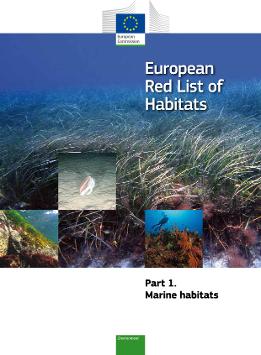
Moore, C. G., Harries, D. B., Lyndon, A. R., Mair, J. M., Tulbure, K. W., Saunders, G. R, Grieve, R. & Brash, J. (2016). 2015 site condition monitoring and site check surveys of marine sedimentary and reef habitats in the Loch nam Madadh SAC and Loch an Duin SSSI. Scottish Natural Heritage Commissioned Report No. 923.
The report can be obtained here.
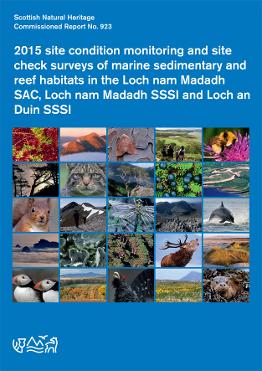
Cook, R. L., Saunders, G. and Dixon, I. (2015). A Littoral and sublittoral benthic survey of the construction footprint for the Carrick landing craft/bund facility, Loch Goil. Report prepared for UPM Tilhill.
The installation of a landing craft/bund facility was proposed for a shore location in Loch Goil, Scotland, with the aim of providing landing craft access to productive woodland where road transport is limited and impractical. The facility would consist of a permanent stone and rock structure forming a short causeway and a hard stand to stack timber. The site lies within the Upper Loch Fyne and Loch Goil Nature Conservation Marine Protected Area and therefore the development required an impact survey to determine whether protected marine habitats were at risk. This document provides the results of the survey undertaken by Dr. Saunders and his diving survey team.
The report can be obtained here.
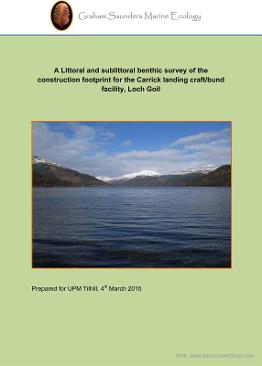
Haynes, T., Bell, J., Saunders, G. Irving, R., Williams J. and Bell G. (2014). Marine Strategy Framework Directive Shallow Sublittoral Rock Indicators for Fragile Sponge and Anthozoan Assemblages Part 1: Developing Proposals for Potential Indicators. JNCC Report No. 524, Nature Bureau and Environment Systems Ltd. for JNCC, JNCC Peterborough.
An examination of approaches for the development of indicators for evaluating the status of shallow sublittoral rock habitats, a requirement under the European Marine Strategy Framework Directive. The main focus is on sponge and anthozoan communities with two proposed indicators, one examining sponge mophological diversity and a second concentrating on species composition. "Real-world" data were used to test the approaches, but the the overarching conclusion is that the level of knowledge and information on these habitats and species is still too sparse to confidently expect to be able to measure human-induced change in these communities.
The report can be downloaded here.
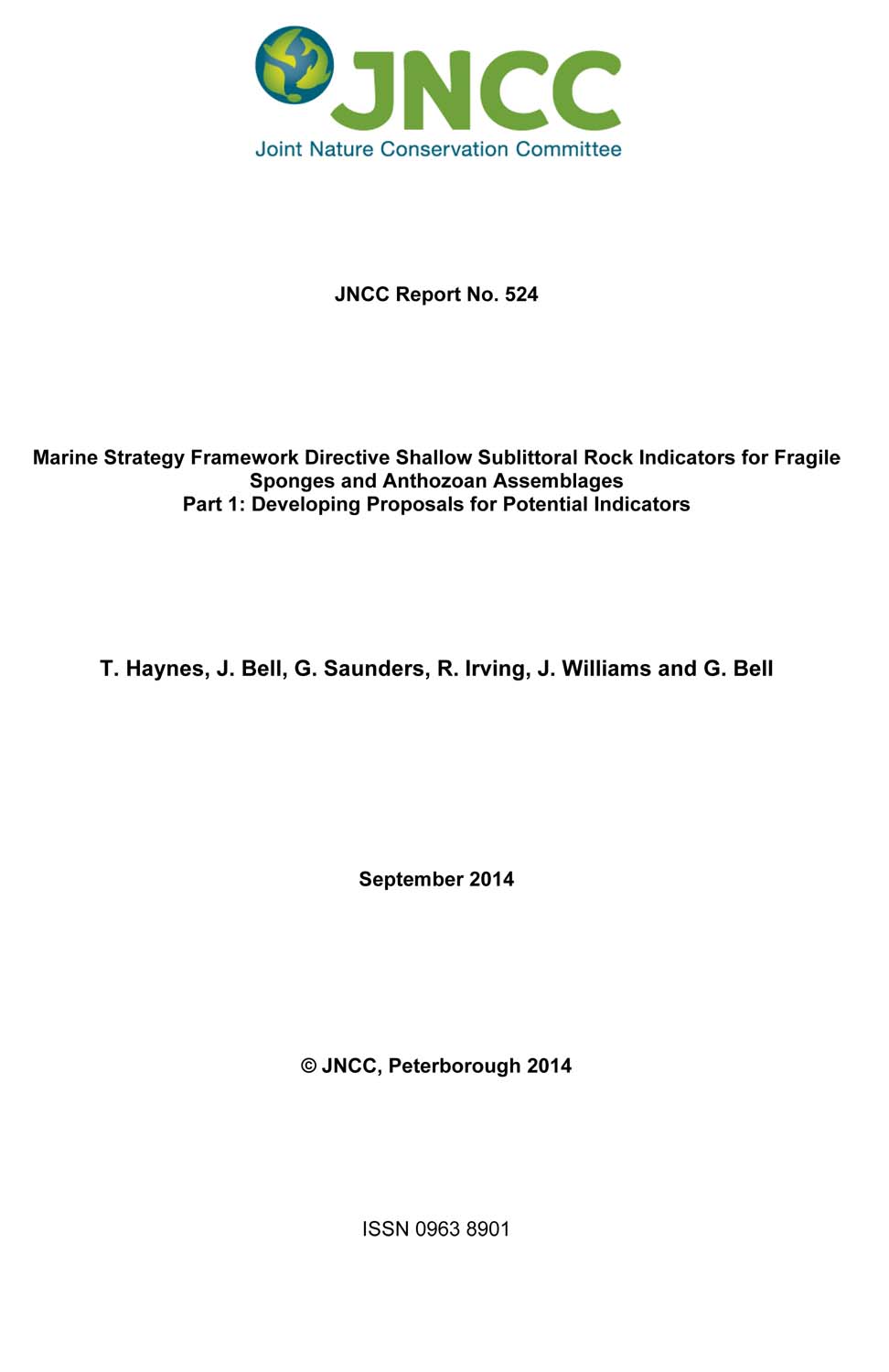
Moore, C.G., Harries, D.B., Atkinson, R.J.A., Clark, L., Cook, R.L., Hirst, N.E., Saunders, G.R., Lyndon, A.R., Sanderson, W.G. and Porter, J.S. (2013). The distribution and condition of proposed selected features within the Loch Sween possible Nature Conservation MPA. pp 253, Inverness: Scottish Natural Heritage. Commissioned Report No. 621.
The results of a survey undertaken in 2013 in the extensive sea loch system of Loch Sween to identify the presence and condition of burrowed and deep mud habitats, maerl, flame shell and native oyster beds. As in previous years this was part of Scotland's programme for the identification of candidate Marine Protected Area locations. The biologically diverse burrowed mud habitat was found to be the most extensive known example in the British Isles, while maerl and oyster beds were observed to be well-represented and in good condition. In contrast, the invasive non-indigenous wireweed (Sargassum muticum) was found to be well-established and no flame shells were found where they had been previously recorded.
The report can be downloaded here.
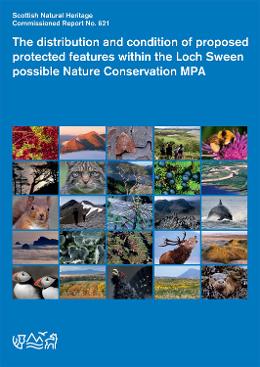
Moore, C.G., Harries, D.B., Cook, R.L., Hirst, N.E., Saunders, G.R., Kent F.E.A., Trigg, C, and Lyndon, A.R. (2013). The distribution and condition of selected MPA search features within Lochs Alsh, Duich, Creran and Fyne. pp 197, Inverness: Scottish Natural Heritage. Commissioned Report No. 566.
The results of an extensive survey programme undertaken in 2012 to establish the presence and condition of particular biological features as a means of identifying potential candidate locations for designation as Scottish Marine Protected Areas. The target biological features were flame shell, maerl and horse mussel beds and burrowed or deep mud habitats. All of these features were found, but the discovery of a flame shell bed extending over 75 ha and supporting a highly diverse associated community in Loch Alsh, was of particular note.
The report can be downloaded here.
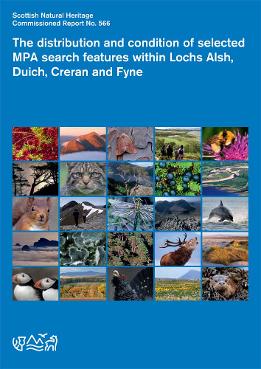
Department of Environment, Community and Local Government (2013). Ireland's Marine Strategy Framework Directive Article 19 Report. Initial Assessment, GES and Targets and Indicators.
An evaluation of the current level of knowledge and environmental status of Irelands coasts and seas, including the identification of pressures and risk in fulfillment of the statutory requirements of the EU Marine Strategy Framework Directive. Dr. Saunders was the MSFD Programme Manager and a primary author of the document.
The report can be downloaded here.
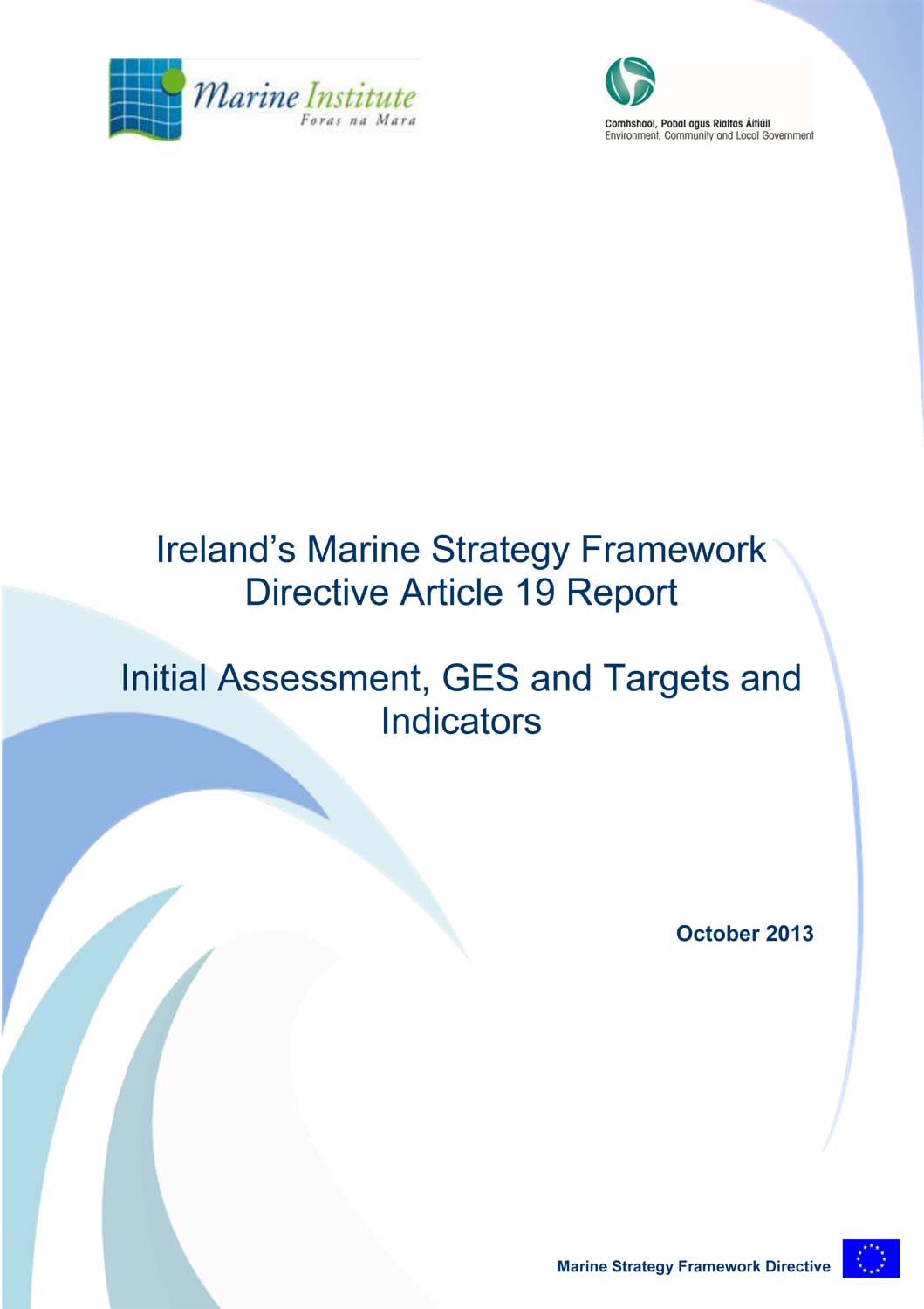
Department of Environment, Community and Local Government (2013). Ireland's Marine Strategy Framework Directive Article 19 Summary Report. Initial Assessment, GES and Targets and Indicators.
A summary of the findings and conclusions of the full report summitted to the European Commission.
The document can be downloaded here.
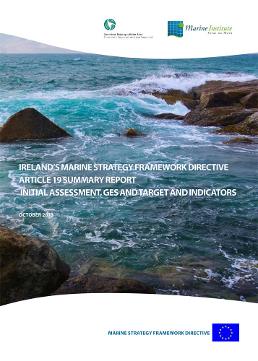
Saunders, G., Bedford, G.S., Trendall, J.R., and Sotheran, I. (2011). Guidance on survey and monitoring in relation to marine renewables deployments in Scotland. Volume 5. Benthic Habitats. Unpublished report to Scottish Natural Heritage and Marine Scotland.
A commissioned guidance document as part of a comprehensive set of guidance and protocols for the conduct of site chracterisation surveys and benthic impact monitoring programmes for marine (wave and tidal) renewables developments in Scotland.
The document can be downloaded here.
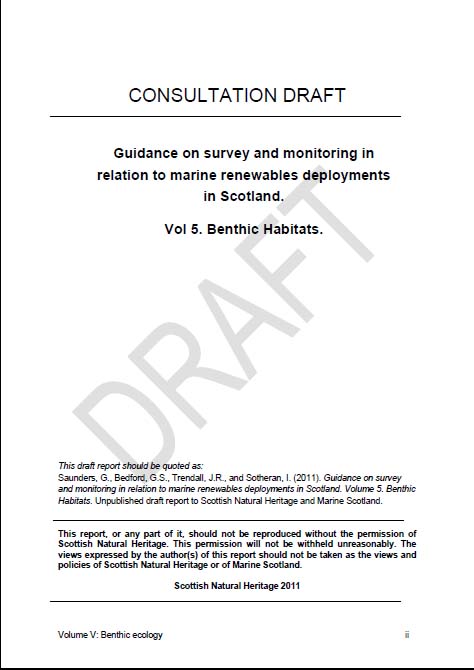
Trendall, J.R., Bedford, G.S., Tarrant, D.C., Fortune, F. and Saunders, G. (2011) Baseline survey and mapping of intertidal features within selected Scottish East Coast SSSI and Ramsar Sites. pp. 504. Battleby: Scottish Natural Heritage. Commissioned Report No. 447.
The results of a series of monitoring surveys undertaken in eleven intertidal SSSI or Ramsar sites on the east coast of Scotland. These locations are particularly notable for the presence of priority seagrass, sand/mudflat and lagoon habitats.
The report can be downloaded here
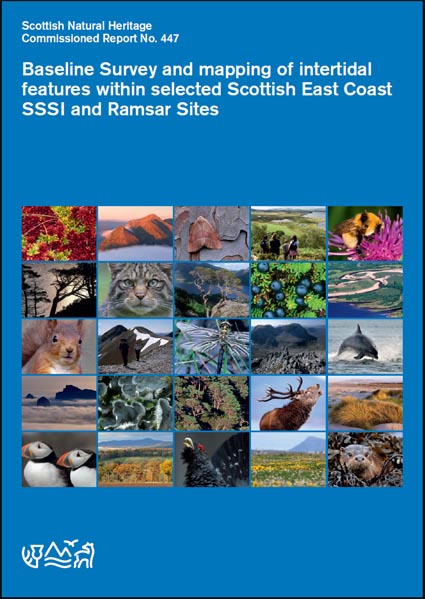
Saunders, G, Velterop, R and Pizzolla, P. (2010) Design of a monitoring programme for Lundy. Natural England, Exeter.
In early 2010 Lundy was designated as the UK's first Marine Conservation Zone. Prior to this it was Natural England's flagship marine protected area, with both SSSI and SAC status, as well as being the UK's only fishery no-take zone. The island and its surrounding seas harbour some rare and unusual habitats and species and has been the subject of a considerable number of surveys and academic studies. This report reviews the available information and evaluates its usefulness as a basis for an integrated long-term monitoring programme, together with presenting a practical and scientifically robust monitoring schedule.
The full report (reproduced by permission from Natural England) can be downloaded here.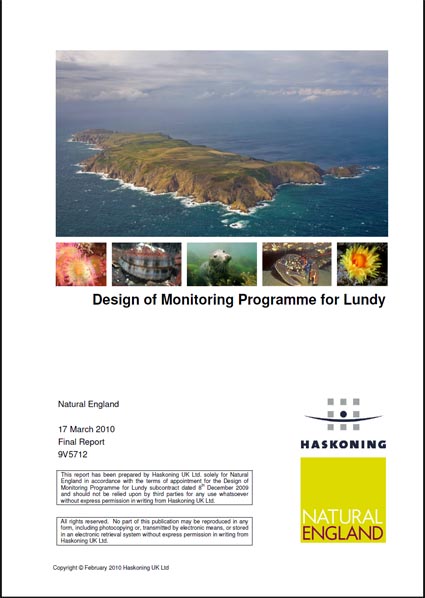
Trendall, J.R., Bedford, G., Lawton, P., Davison, D.M., Fortune, F. and Saunders, G., 2010. Assessment of the spread of the non-native species Sargassum muticum: Solway Firth to the Ardnamurchan Peninsula. pp. 251. Battleby: Scottish Natural Heritage. Commissioned Report, No. 347.
The invasive non-native brown seaweed Sargassum muticum has only recently been recorded in Scottish waters. This report presents the results of a study in which predictive digital mapping (GIS) based on tidal flows, wind influence and the occurrence of favourable seabed substrates was used to identify likely locations where early colonisation might take place. The identified high vulnerability locations were then subjected to field visits to determine if S. muticum was present. Some of the predicted areas did indeed support recently-established colonies of the seaweed.
The full report can be downloaded here.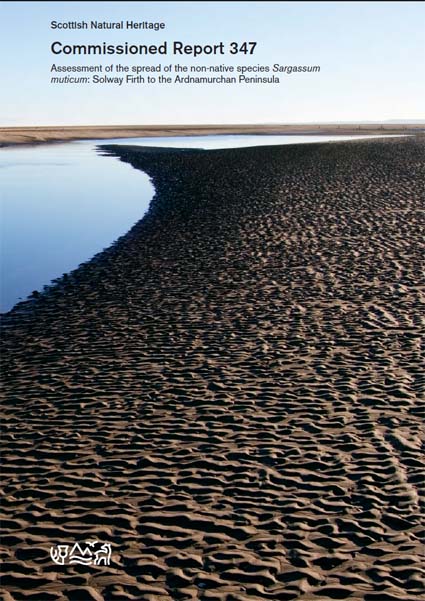
Saunders, G. and Scott, M. (2010). Scottish Marine Ecosystem Objectives: Scoping Study. Scottish Natural Heritage. Commissioned Report, No. 341.
A scoping study commissioned to evaluate the Scottish Government's current and future comittments and obligations in respect of marine planning, monitoring and adaptive management. The main focus is developing the mechanism by which the principles of an 'ecosystem-based approach' can be applied. A practical tiered system is proposed with international examples of similar approaches presented and critically assessed.
The full report can be downloaded here.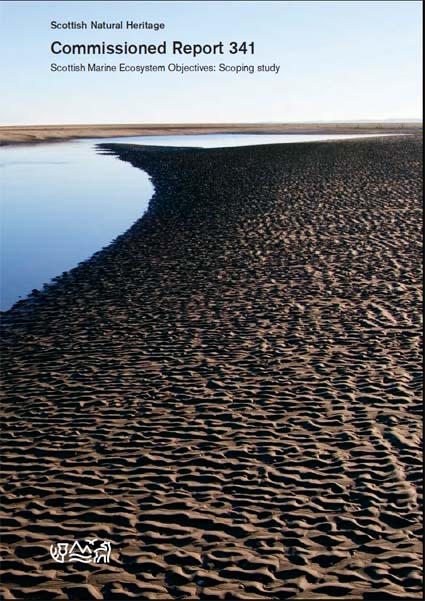
Greathead, C., Donnan, D. W., Saunders, G. R. and Mair, J. M., (2007). Sea pens. Scotland's secret forests. JMBA Global Marine Environment, 24-25.
A profile of Scotland's three sea pen species and their vulnerability to seabed fishing practices. The article is illustrated with a number of photographs taken by Dr. Saunders. A companion article to the paper:
Greathead, S. F., Donnan, D. W., Mair, J.M. and Saunders, G. R. (2007). The sea pens Virgularia mirabilis, Pennatula phosphorea and Funiculina quadrangularis: distribution and conservation issues in Scottish waters. Journal of the Marine Biological Association of the UK. 87 5623/1 139.
The article can be downloaded here:
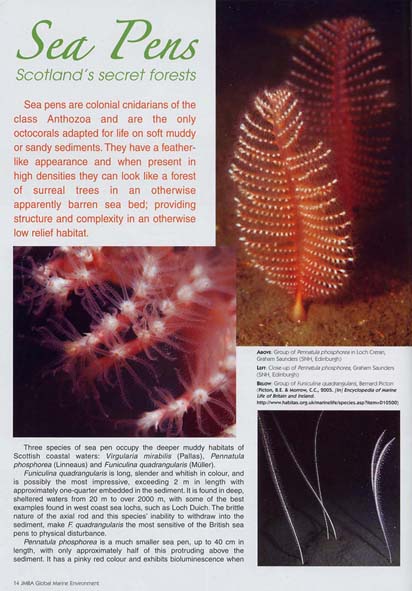
Moore, C. G., Saunders, G., Mair, J. M. and Lyndon, A. R. (2006). The establishment of site condition monitoring of the saline lagoon Loch an Duin, North Uist Site of Special Scientific Interest. Scottish Natural Heritage, Commissioned Report, No. 150. Battleby, Perth.
The results of the first site condition monitoring survey of the extensive saline lagoon system in North Uist, Western Isles, which are protected under multiple conservation designations. The site consists of a series of inter-connecting lagoonal basins and tidal narrows supporting dense areas of ecologically important eelgrass and tasselweed, together with two nationally rare species of stonewort.
The full report can be downloaded here.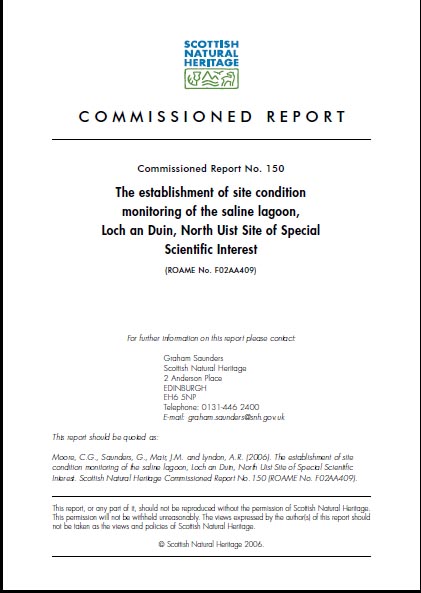
Moore, C. G., Saunders, G., Mair, J. M. and Lyndon, A. R. (2006). The inauguration of site condition monitoring of marine features of Loch Maddy Special Area of Conservation. Scottish Natural Heritage, Commissioned Report, No. 152. Battleby, Perth.
The results of the first site condition monitoring survey of the Loch Maddy Special Area of Conservation. The site extends over a large area and incorporates a diverse range of habitats and species, including intertidal and subtidal rocky reef, intertidal and subtidal sediments and saline lagoons. The lagoons (seaward extensions of the Loch an Duin system - see report above) and associated tidal narrows were rich in eelgrass, nationally rare species of charophytes and extensive areas of species-rich maerl. The rocky reefs were found to be extremely biodiverse, supported relatively dense areas of cup corals, northern sea fan and a range of sponges.
The full report can be downloaded here.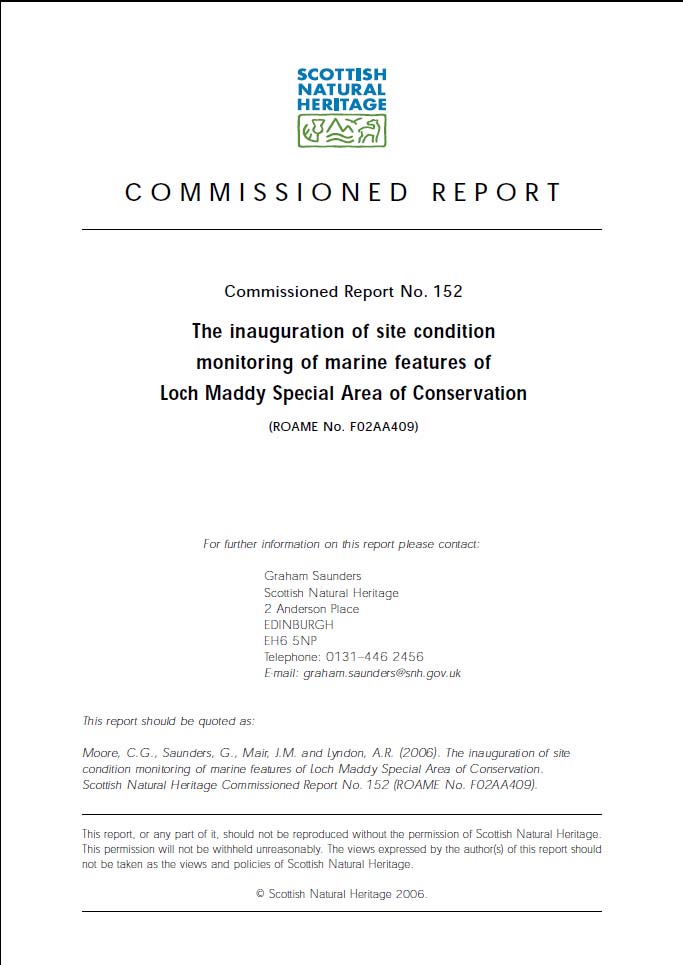
Saunders, G. R. and Moore, C. G. (2004). In situ approach to the examination of the impact of copper pollution on marine meiobenthic copepods. Zoological Studies. 43: 350-365.
An account of a study incorporating a unique manipulative field experiment in which a small area of muddy seabed was contaminated with levels of copper that are analagous to concentrations found in locations subjected to moderate to high human influence. The experimental plot was sampled pre- and post contamination using a randomised grid design and the effect on the numerically dominant meiobenthic copepod (very small shrimp-like crustaceans) community was determined at the species level using both univariate and multivariate statistical methods. The results suggest species and life-stage specific susceptibility to metal contamination and provide some evidence for an 'intermediate disturbance' effect.
The full peer-reviewed paper can be downloaded here.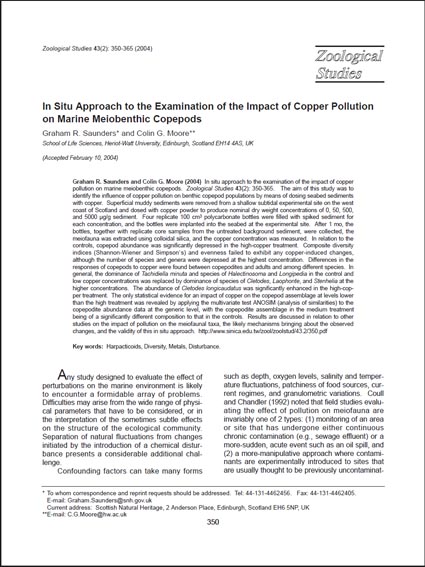
Saunders, G. (2004). Natural heritage trends: the seas around Scotland 2004. Scottish Natural Heritage, Battleby. 158 pp.
A full account of an extensive literature and data review attempting to evaluate the state of the Scotland's marine environment. Subject areas include the current state of knowledge, human use of the sea and associated conflicts, conservation initiatives, marine life and ecology, fisheries and the current and predicted effects of climate change. Note: a more up-to-date publications may now exist.
The complete book can be downloaded here.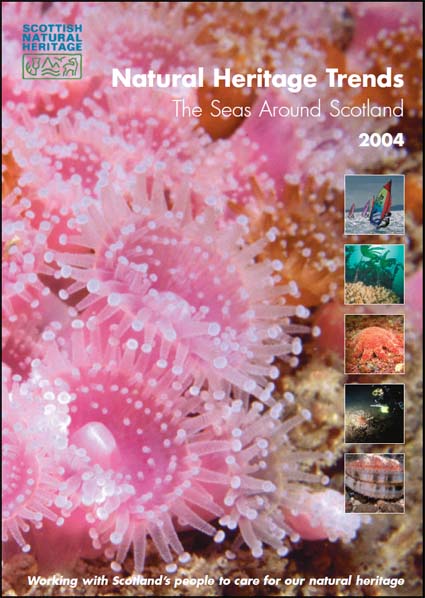
Wilson, J., Mackey, E., Mathieson, S., Saunders, G., Shaw, P., Walker, I., Watt, A. and West, V. (2003). Towards a strategy for Scotland's biodiversity: developing candidate indicators of the state of Scotland's biodiversity. Scottish Executive Environment Group/Scottish Biodiversity Forum, Paper 2003/6. Edinburgh.
A paper produced for the Sottish Biodiversity Forum making a case for the development of suite of specifically Scottish biodiversity indicators as a tool for evaluating the progress and effectiveness of sustainable development initiatives. Note: this has resulted in the subsequent adoption of an established set of published Scottish Biodiversity Indicators.
The full paper can be downloaded in pdf format here, or viewed as a web page here.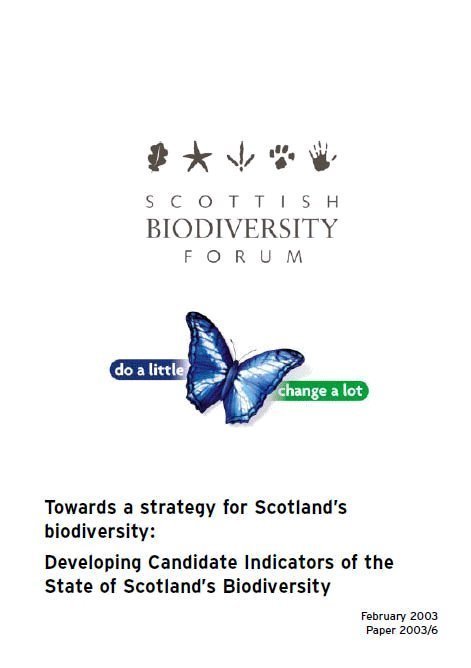
Mackey, E. C., Shaw, P., Holbrook, J., Shewry, M. C., Saunders, G., Hall, J. and Ellis, N. (2001). Natural heritage trends: Scotland 2001. Scottish Natural Heritage, Battleby, Perth. 200 pp.
A review of trend data relating to status of Scotland's natural environment, examining the situation at both a broad 'human effects' level and using a more detailed 'key species' approach. Note: a more up-to-date publication may be available.
The complete book can be downloaded here.
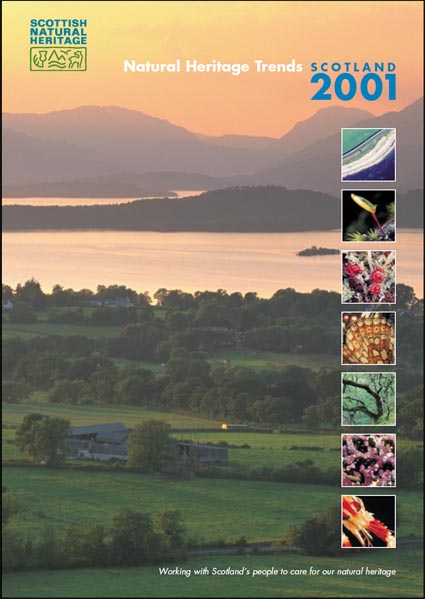
© 2021 Graham Saunders. All Rights Reserved